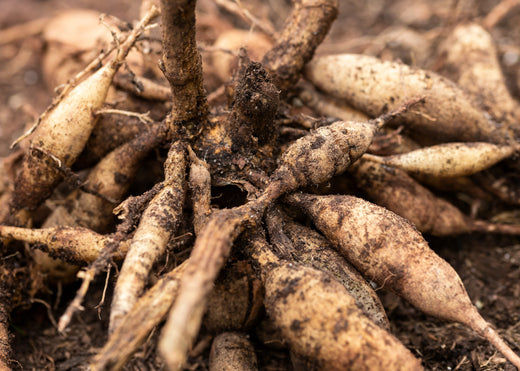
Dahlia Tubers
Share
When it comes to growing dahlias, understanding their unique tubers is key to unlocking a spectacular garden display. Dahlia tubers are not your typical seeds; they are nutrient-packed storage organs that hold the potential for lush, vibrant blooms. If you’ve ever wondered why some gardeners rave about dahlias, it’s because these flowers are as diverse as they are beautiful, thanks to their tuberous roots.

Dahlia Tubers vs. Seeds
While dahlia seeds can be used to grow plants, they come with a few challenges. Seeds are genetically diverse, which means you’re unlikely to know what type of bloom you’ll get. They’re often a mystery grab bag, perfect for those who love surprises but less predictable for specific landscaping needs. On the other hand, dahlia tubers are clones of the parent plant, guaranteeing that the flower’s color, shape, and size will match your expectations.
Tubers also give your plants a head start. Unlike seeds, which require extra time to germinate and grow, tubers already have the energy and nutrients stored to fuel rapid growth. This means earlier blooms, stronger plants, and a more robust garden overall.
Tubers Come in All Shapes and Sizes
One of the fascinating things about dahlia tubers is their variety. They can range from small, single tubers to large, multi-eyed clusters. The size doesn’t necessarily determine the size of the blooms, but each healthy tuber with a visible “eye” (a growth point) holds the promise of a new plant. Some varieties produce compact tubers that are easy to store and plant, while others create sprawling masses that require a bit of care to divide and prepare.
Caring for Dahlia Tubers
To ensure success, it’s essential to handle your dahlia tubers with care. When planting, choose a sunny spot with well-draining soil. Dahlias thrive in rich, loamy soil, so consider amending your garden bed with compost to provide the nutrients these hungry plants crave. Place the tuber horizontally in the soil, about 4-6 inches deep, with the eye facing upwards. Water sparingly until you see sprouts, as overwatering can lead to rot.
At the end of the growing season, after the first frost, you’ll need to dig up your tubers if you live in a region with cold winters. Allow them to dry, brush off excess soil, and store them in a cool, dry place until it’s time to plant again. With proper care, your tubers can last for years, providing season after season of stunning blooms.

The Magic of Dahlia Diversity
Dahlia enthusiasts know that the true joy of these flowers lies in their variety. From the dinner-plate-sized blooms of the larger varieties to the delicate, pom-pom-like shapes of smaller types, there’s a dahlia for every garden style. Whether you’re creating a dramatic focal point or adding a splash of color to a mixed border, dahlias are a gardener’s dream.

Why Choose Tubers?
By choosing tubers, you’re investing in consistency, reliability, and a head start on growing season success. Unlike seeds, tubers let you recreate the exact bloom you fell in love with, year after year. Plus, dividing tubers gives you even more plants over time, making them an economical and rewarding choice for any garden.
Happy planting!
